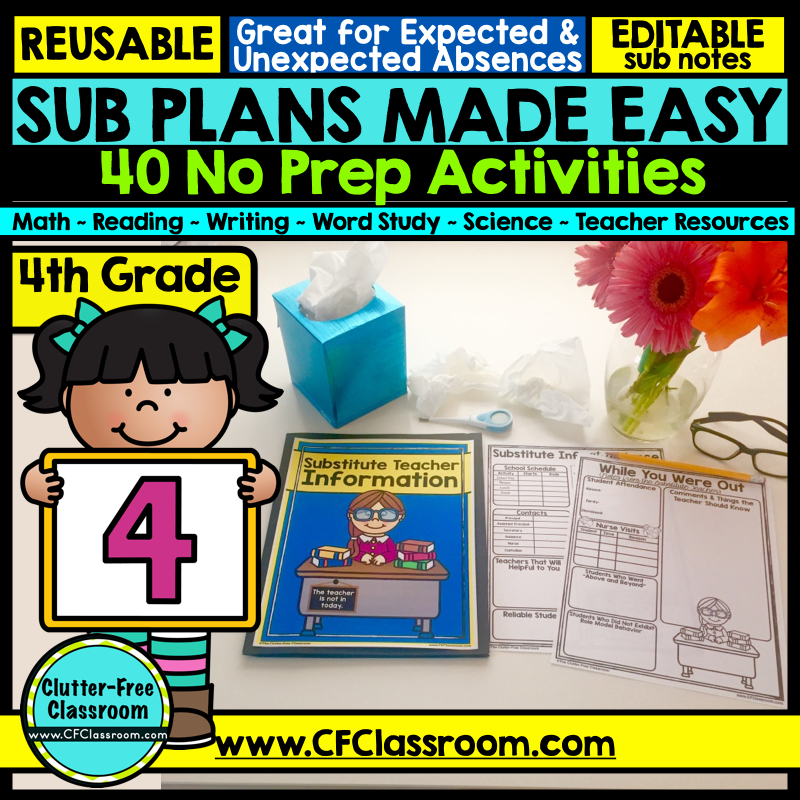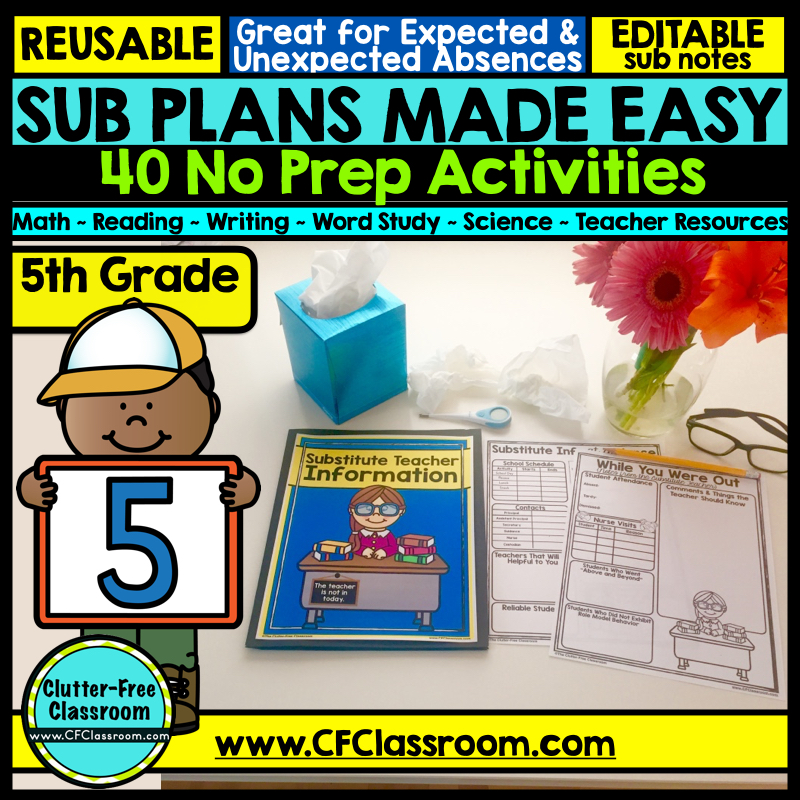As teachers, we know how important it is to stay healthy in order to both help our students healthy and create a productive classroom environment. It can be challenging to maintain a healthy routine and lifestyle when the school year gets busy. It is very common for teachers to prioritize their work over their health and wellness. However, this is when healthy habits matter the most!
Ursula Foster once said, “You can’t pour from an empty cup”. This is so true! In order for us to give to our students, their families, and our school community, we must first take care of ourselves. Easier said than done, right? Stay happy and healthy at work during flu season, the winter, and all year long and maintain a healthy classroom environment by following the advice outlined below!

5 Ways to Maintain a Healthy Classroom Environment
Here are 5 ways to maintain a healthy classroom environment and keep your classroom clean!
- Use disinfectant wipes on all hard and frequently-touched surfaces in the classroom (e.g. tables, desks, door knobs, and classroom phone). Perhaps you could create a routine where students wipe down their desks/tables after eating snack and/or the end of the day using disinfectant wipes.
- Explicitly teach students hygienic habits (e.g. how to wash their hands properly and how to sneeze into their elbow). After teaching them the importance of doing these things, invite students to wash their hands before eating (e.g. snack and lunch) and after coughing, sneezing, or blowing their nose.
- Encourage students to adopt a healthy lifestyle, which involves eating nutritious foods, drinking lots of water, and getting plenty of sleep. Lead by example by discussing your own personal habits.
- Shift to individual student supplies instead of community supplies. This could involve a pencil boxes with pencils, hand-held pencil sharpeners, crayons, scissors, erasers, and glue sticks.
- Contact parents and share tips to help decrease the spread of germs in school (e.g. going to bed early and eating nutritious foods). Perhaps this could be sent in an email or as part of a newsletter. In addition, ask students’ families for donations of boxes of tissues and disinfectant wipes.
How to Prepare for When You Get Sick
Even when you take all of the steps to have a healthy classroom environment, sickness can still pop up.
I know what you’re thinking. It’s so much easier to tough it out at school than have to write sub plans. Trust me, I know how challenging sub plans can be. But I have good news: they don’t have to be! I have print and go sub plans that will make your life SO much easier! They are now digital, too!
If and when you do get sick, it is important to take time to rest and recover in order to prevent it from developing into something worse. When your immune system is weakened, you are far more susceptible to other germs and viruses.
I can speak from personal experience. In 2016, I came down with what seemed like a common cold and, although I felt like crud, I adopted the “it’s easier to go to school not feeling well than it is to stay home” mentality. I pushed myself through several days of teaching while I was fighting the cold. Instead of getting better, it developed into pneumonia. I then missed not only several weeks of school, but spent Christmas and the entire holiday break in bed feeling miserable, had to pay a ton of medical bills and developed complications from the antibiotics that were prescribed. What a nightmare! I can’t help but wonder how that experience may have been different if I had just listened to my body and taken a couple days to rest at home when I knew I was not feeling well.


10 Tips for How to Stay Healthy as a Teacher and Not Get Sick
In addition to creating a healthy classroom environment, it’s important to keep your body healthy.
1. Eat Nutritious Foods
Maintain a balanced diet with colorful foods from different food groups. Remember to start the day off right with a delicious and healthy breakfast. Also, don’t forget to pack a good lunch and lots of snacks. Eat healthy meals that are both filling and delicious!
2. Exercise Regularly
Start your day with an intense 30 minute workout before you take a shower, go for a walk after school, do pushups and sit-ups before you go to bed… It doesn’t matter what you do. Move your body as much as you can throughout the day!
3. Drink Lots of Water
It is commonly recommended to drink at least 8 glasses of water per day. Make this a priority so that your body can fight off germs and keep feeling good.
4. Get Enough Sleep
Instead of staying up late and watching TV, head to bed early with a good book. This will help you wake up feeling refreshed and ready to take on the day!
5. Listen to Your Body
If your body is feeling tired and overworked, listen to it by resting and going to bed early. Your body tells you what it needs.
6. Wash Your Hands Frequently
Wash your hands after you use the bathroom, before you eat anything, before you go home from school, and whenever you touch something that likely has germs.
When you wash your hands, remember to follow this procedure: 1) wet your hands, 2) get soap, 3) lather it between your palms, 4) rub the backs of your hands one at a time, 5) interlock your fingers to get in between your fingers, 6) scrub your fingernails, 7) rub your wrists, 8) rinse the soap off of your hands, 9) and dry them.
This is a great way to maintain a healthy classroom environment as well.
7. Do Things you Love
Make time for getting together with a friend for coffee on a weekend morning, take an art class, or whatever speaks to your soul. Do things that make you feel good so that you can continue feeling good.
8. Wipe Down Hard and Frequently Touched Surfaces Using Disinfectant Wipes
Do this at home, in your car, and at school. Keeping everything clean and disinfected will make it much easier for you keep germs at bay. This is a great way to maintain a healthy classroom environment.
9. Change your Clothes when you get Home from School
By getting changed, it reduces the spread of germs from outside of the house coming into your house.
10. Get a Flu Shot
This helps your body fight off getting the flu.

10 Healthy Teacher Breakfasts
Below are 10 healthy classroom teacher breakfasts.
- quiche and raspberries
- eggs and strawberries
- banana and peanut butter
- smoothie
- avocado toast
- vegetable omelette
- oatmeal and blueberries
- yogurt with blackberries
- whole wheat toast with peanut butter
- bowl of cereal with banana slices on top
20 Healthy Teacher Snacks
Below are 20 healthy classroom teacher snacks.
- blueberries
- strawberries
- blackberries
- raspberries
- grapes
- banana
- apple
- orange
- pear
- watermelon
- yogurt
- cheese stick
- hard boiled egg
- trail mix
- almonds
- dried fruit
- popcorn
- hummus
- carrots with ranch dip
- celery with peanut butter
Sub Plans Resources
Even when we try our best to create a healthy classroom environment and maintain a healthy routine, there will be times when you need to call out sick. Here are some additional resources related to preparing for a substitute teacher and writing sub plans.
- Grades 1-5 Sub Plans Bundle
- 1st Grade Sub Plans
- 2nd Grade Sub Plans
- 3rd Grade Sub Plans
- 4th Grade Sub Plans
- 5th Grade Sub Plans
In closing, we hope you found these tips for how to create a healthy classroom environment helpful. If you did, then you may also be interested in the resources below.
- Read these other blog posts about planning for a substitute teacher.
- Download the free Clutter-Free Classroom’s Guide to Preparing for a Substitute Teacher.
- Buy the printable and digital emergency sub plans: Grades 1-5 Sub Plans Bundle.








